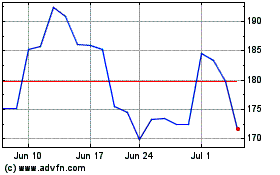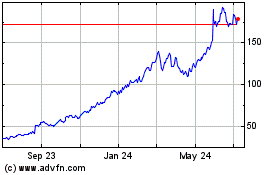Retailers Shed Jobs For First Time In 2010 As Caution Grows
June 04 2010 - 12:41PM
Dow Jones News
U.S. retailers reversed track on hiring in May, shedding jobs
after steadily adding them since the year began.
The retail industry reported a decline of 6,600 positions as
consumer spending slowed and seasonal hiring was relatively
complete, and perhaps overdone, given the decline of 4,000 building
material and garden supply jobs the federal government
reported.
Just a handful of retail categories added spots, including
electronics and appliance stores and health and personal care
stores. Non-store retailers, primarily online sellers, reported a
slight gain, according to the nonfarm payroll report the Labor
Department released Friday.
Department stores continued to be a relative weak spot, shedding
1,400 positions last month. Department stores are part of a larger
general merchandise category that includes discounters and mass
merchants.
Retailers are reluctant to add workers because of unease about
consumers' financial health. "There is significant concern by
retailers that a lot of the spending we saw earlier in the year was
based on pent-up demand and was temporary," said Robert Yerex,
chief economist at Kronos, which makes employee time management
systems for retailers. "As a result, retailers are not adding jobs
and not replacing all of the employees that leave."
May was a period of domestic and global turmoil that could have
factored into retailers' hiring decisions because consumers are
sensitive to disruptive events. In the U.S., overall unemployment
remains high and the ongoing Gulf of Mexico oil leak is casting a
pall. Conditions overseas were tenuous, with fear that other
European countries may develop debt crises similar to Greece.
Political tensions in North Korea and the Middle East escalated as
well.
May's decline came after retailers added 18,500 positions in
April, 22,700 in March, 7,100 in February and 49,100 in
January.
The retail industry is part of the non-farm payroll report that
was released Friday that showed U.S. employers added 431,000
positions last month, the largest gain since March 2000, aided by
census hiring. While the unemployment rate for the retail industry
rose to 10% from 9.6%, the U.S. unemployment rate dropped to 9.7%
from 9.9%.
While retail employment fell, other parts of the economy are
showing strength. Manufacturing continued to trend up, rising by
29,000. Employment in professional and business services rose by
22,000.
The retail industry cut 1.2 million positions between December
2007 and December 2009, according to Labor Department figures.
Retail employment is now about 14.4 million, making the sector the
nation's fourth-largest employer behind government, health care,
and professional and business services.
About 20% of the positions the retail industry lost during the
recession probably aren't returning because consumer spending is
more subdued and is not likely to rebound quickly, Yerex said. "I
do not believe we will get to the peak level we were at" in
December 2007, when retail employment in the U.S. hit 15.6
million.
The nonfarm payrolls report came a day after retailers reported
a muted rise in sales at stores open at least a year, with the
increase not as high as expected.
Discounters and mass merchants including Costco Wholesale Corp.
(COST) and BJ's Wholesale Corp. (BJ) had some of the strongest
gains, while teen retailers including Abercrombie & Fitch Co.
(ANF) and American Eagle Outfitters Inc. (AEO) experienced
declines.
-By Karen Talley, Dow Jones Newswires; 212-416-2196;
karen.talley@dowjones.com
Abercrombie and Fitch (NYSE:ANF)
Historical Stock Chart
From Jun 2024 to Jul 2024

Abercrombie and Fitch (NYSE:ANF)
Historical Stock Chart
From Jul 2023 to Jul 2024
